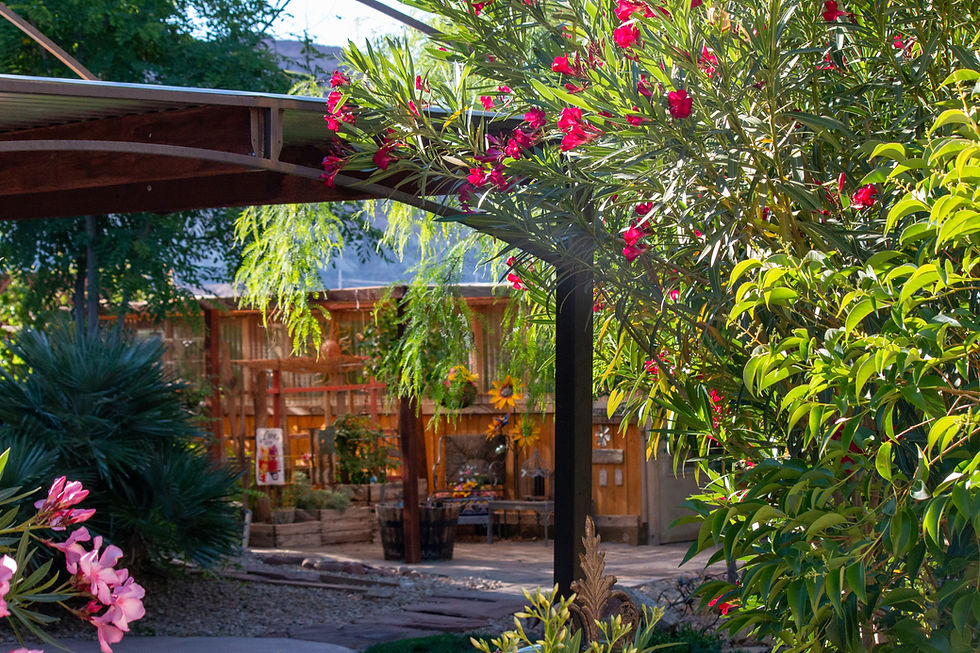PGSU Garden Story: Chris
- Parade of Gardens Southern Utah

- Sep 8
- 3 min read

When Chris moved from Las Vegas to St. George in 2017, he brought with him a deep passion for desert living and a multigenerational family history of desert dwellers. His new home in the Washington/Green Springs area came with a professionally installed landscape, but Chris found it sterile and lifeless.
Determined to transform it, he began building something far more vibrant—a young permaculture garden, also known as a food forest, designed to thrive with minimal water, mimic natural systems, and support abundant life.

Building a Food Forest in the Desert
Chris’s gardening journey began years ago when friends in northern Utah convinced him to grow his first tomato. That spark eventually led him to experiment with permaculture in southern Utah. He dug small swales to collect rainwater and seeded them with wildflowers for ground cover—only to lose it all to a pocket gopher. Instead of giving up, Chris studied the forest floor during a trip to Washington State. He asked himself: how does nature manage water, feed itself, and live in balance with wildlife?
Back home, he applied those lessons. He began layering organic matter in his yard, practicing “chop and drop” by cutting branches from olive trees, crepe myrtles, and fruit trees and leaving them on the ground to enrich the soil. He learned to companion plant tightly—fruit trees, shrubs, vegetables, herbs, grapes, and berries all sharing space. In his garden, trees shade smaller plants, and roots intertwine to share nutrients. The result is remarkable: food production nearly year-round, from early strawberries, to ever-bearing figs, to late pomegranates.

Nature Finds Its Balance
Chris’s backyard now resembles a desert forest floor. Large grapevines provide protection for understory blackberries, while strawberries spread at the base of fruit trees. Seeds and pits dropped into compost holes sprout with the help of thriving microbial life. A kit fox even claimed a corner of the garden this winter, delighting Chris and his children.
In this dense ecosystem, trees require little water, even during extreme heat. Chris has found that watering too much in hot, dry weather can actually stress plants, causing them to grow rapidly and lose more moisture. Instead, he allows them to slow down, retaining water until cooler conditions return. Creating humidity in protected areas—like against a wall—helps support plants during these periods.

Gardening as Experiment
Beyond fruit and vegetables, Chris is especially drawn to cacti. His kitchen is filled with seedlings of Trichocereus bridgesii and Echinopsis pachanoi grown from seed, a project he shares with his children. For Chris, gardening is an endless experiment—plants surprise him with where they succeed and how they coexist. He encourages others not to fear failure, reminding us that even seasoned gardeners struggle, especially in desert conditions.
Ultimately, Chris sees gardening as both practical and philosophical. “I believe I share this land, I don’t own this land,” he says. “And if I’ve taken it from some source, I want to be able to give back to that source.”

Garden Wisdom from Chris
Mimic nature. Companion plant tightly and use “chop and drop” to build your soil like a forest floor.
Rethink watering. In extreme heat, less water can help plants retain moisture rather than stress them with new growth.
Let wildlife in. A kit fox, chickens, or beneficial insects can become part of a healthy ecosystem.
Experiment boldly. Propagate, seed, and try new plants—surprises often bring the best results.
Learn from others. Chris recommends following desert gardening expert Noelle Johnson (the “Arizona Plant Lady” at azplantlady.com or on Facebook) for practical tips.




Comments